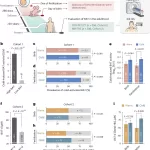University of Surrey Research Offers Practical Solutions to Improve Classroom Air Quality
Introduction: A recent study conducted by the University of Surrey reveals promising strategies to mitigate classroom pollution, emphasizing the use of air purifiers and scheduled window openings. The research highlights the importance of implementing tailored approaches to address air quality concerns in educational settings, offering practical solutions for schools grappling with air pollution challenges.
Key Findings:
- Effective Strategies: Researchers at Surrey’s Global Centre for Clean Air Research (GCARE) found that alternating air purifiers with scheduled window openings significantly improved air quality in classrooms. This approach resulted in a reduction of coarse particle pollution by up to 36% and carbon dioxide levels by up to 28%.
- Tailored Approach: Nidhi Rawat, a researcher at GCARE, emphasizes the importance of adopting a tailored approach based on classroom characteristics and location. By understanding the dynamics of air pollution and teacher schedules, schools can optimize the use of air purifiers and window openings to enhance indoor air quality effectively.
- Practical Considerations: While opening windows may not always be feasible or comfortable, especially in urban areas with high levels of outdoor pollution, the study underscores the need for a sensible and practical approach to classroom ventilation. Alternating between air purifiers and scheduled window openings offers a balanced solution to reduce pollution levels effectively.
Methodology: The study monitored pollution levels in two classrooms at an infant school in Guildford, UK, situated near a busy road frequented by thousands of vehicles daily. By analyzing air quality improvements in classrooms occupied by different age groups and facing varying pollution levels, researchers gained valuable insights into the efficacy of different ventilation strategies.
Implications and Recommendations:
- Policy Guidance: Professor Prashant Kumar, director of GCARE, highlights the study’s relevance for policymakers aiming to address air pollution in educational environments. By leveraging the findings, policymakers can develop targeted interventions to create safer and healthier learning spaces for children worldwide.
- Global Impact: The study aligns with the United Nations Sustainable Development Goals, particularly goals related to health, education, and sustainable cities. By prioritizing air quality improvements in classrooms, the research contributes to broader efforts to promote well-being, quality education, and sustainable urban development.
Conclusion: The University of Surrey’s study offers valuable insights into practical strategies for reducing classroom pollution, emphasizing the importance of tailored approaches and effective ventilation techniques. By implementing recommendations such as alternating air purifiers and window openings, schools can create healthier environments conducive to learning and well-being.












